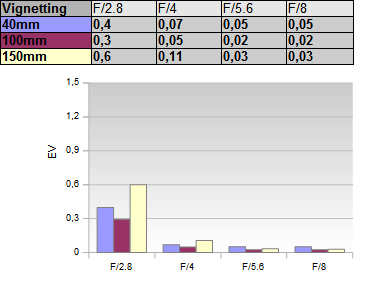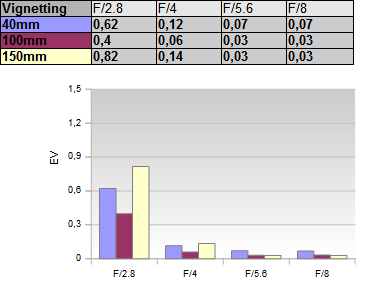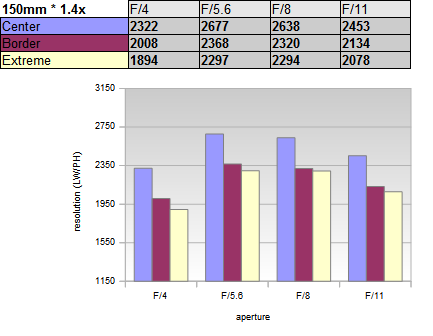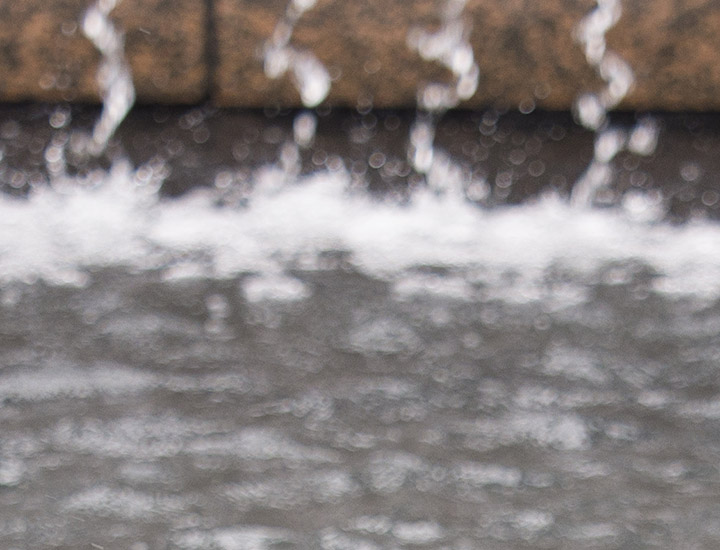|
Olympus M.Zuiko Digital ED 40-150mm f/2.8 PRO - Review / Test Report - Analysis |
|
Lens Reviews -
(Micro-)Four-Thirds
|
|
Page 2 of 3

Distortion
The Micro-Four-Third system uses an automatic distortion-correction under the hood thus from a user perspective, this is nothing to worry about. The measured distortions are all south of 0.1%!
While most RAW converter as well as the camera (JPEGs) don't give you a choice, a few still do (e.g Capture One) thus it is actually possible to verify the original characteristic of the lens. With disabled auto-correction, the Olympus lens shows a 2% barrel distortion at 40mm although nothing worth to mention beyond.
Vignetting
Auto-correction is also applied to the vignetting characteristic. The systems shows a very mild light falloff at 40mm and 100mm. At 150mm f/2.8 it's a bit more noticeable at 0.6EV (f-stops) but normally you don't need to care really. The issue is absolutely negligible from f/4 onward.
 The RAW vignetting is slightly higher although most of this seem to relate to the uncorrected distortion actually. The RAW vs JPEG results aren't completely comparable due to the different tone curves here. In any case, it's not a hell of a difference.
The RAW vignetting is slightly higher although most of this seem to relate to the uncorrected distortion actually. The RAW vs JPEG results aren't completely comparable due to the different tone curves here. In any case, it's not a hell of a difference.

MTF (resolution)
The Olympus M.Zuiko ED 40-150mm f/2.8 Pro delivered impressive results in the MTF lab. At 40mm the center is pretty much excellent from f/2.8 onward. The borders/corners are good to very good. Diffraction has a higher impact from f/8 although f/11 remains usable. The 100mm setting is clearly the sweet spot. The center performance remains intact whereas the quality of the outer image region is boosted significantly. At medium apertures the borders are even reaching excellent levels which is rare for a zoom lens. Even the corners are easily very good at mainstream settings. 150mm sees a slight decrease across the image region but not by much.
The tested sample had an okay to good centering quality.
Please note that the MTF results are not directly comparable across the different systems!
Below is a simplified summary of the formal findings. The chart shows line widths per picture height (LW/PH) which can be taken as a measure for sharpness.
If you want to know more about the MTF50 figures you may check out the corresponding Imatest Explanations

MTF (resolution) at 150mm with Olympus 1.4x Converter
To be honest with you - I was never overly fond of tele-converters. Tele-converters extend the reach, yes, but they also magnify the imperfections of the base lens - and zoom lenses have more than primes- and add their own thus they will always be a second grade choice. As a rule of thumb, a 1.4x converter costs about "one rating mark" thus also "two rating marks" for a 2x converter (which therefore rarely turns out good). Furthermore they increase the maximum aperture by their converter factor so they are pushing the resulting combination further into diffraction (smaller aperture). Consequently they work best with fast lenses. E.g. putting a 2x converter on a f/5.6 lens (effectively f/11) is not a good idea.
Now the Olympus M.Zuiko is reasonably fast (f/2.8) so the Olympus 1.4x converter translates this combination into a 56-210mm f/4 which is actually not a bad base. However, the penalty caused by the converter remains. This most obvious at maximum aperture (210mm) which is the point where the base lens is also the least "robust" (thus most vulnerable to centering imperfections). The result isn't bad but the center is just good to very good followed by fair to good borders/corners. A perfectly centered lens (if it exists) will be somewhat better here. Stopping down boost the quality substantially towards a very good center and good/corners.
Consequently the combination had only an okay centering quality. We would certainly recommend to attach the converter only when needed.

Chromatic Aberrations (CAs)
Lateral CAs (color shadows at harsh contrast transitions) are just slightly visible with an average pixel width of around 1px at the image borders at the extreme ends of the range and a bit less in between. This is not disturbing.

Bokeh
The Micro-Four-Thirds system isn't overly well suited towards shallow depth-of-field photography. The small sensor and its 2x crop factor is limiting the potential here. As mentioned before the Olympus M.Zuiko Digital ED 40-150mm f/2.8 Pro "behaves" like a full format "80-300mm f/5.6". Now that all being said it is, of course, possible to isolate your subject from the background although the difficult focus transition zone is comparatively deep so the smooth rendition of the bokeh is correspondingly difficult.
Unfortunately the Olympus lens has a clear weakness here - just like its Four-Thirds "predecessor" (Olympus Digital Zuiko ED 50-200mm f/2.8-3.5 SWD) actually. This is especially disappointing because the Olympus marketeers state otherwise. The first three sample crops below illustrate the degree of the bokeh roughness that you have to face.
 The following sample crop is a bit of a torture test due to the harsh contrast but it clearly shows a so-called "Nisen" bokeh - thus sharply rendered out-of-focus stripes rather than graduated ones.
The following sample crop is a bit of a torture test due to the harsh contrast but it clearly shows a so-called "Nisen" bokeh - thus sharply rendered out-of-focus stripes rather than graduated ones.
 Out-of-focus highlights show an outlining effect as shown in the next image. Aspherical elements (the lens has a couple) are often the cause for this.
Out-of-focus highlights show an outlining effect as shown in the next image. Aspherical elements (the lens has a couple) are often the cause for this.
 I'm sure many owners will be in disbelieve. However, please note that the above doesn't mean that you can't produce smooth backgrounds altogether - just see below. This simply requires a rather pronounced focus spread - thus the distance between main subject and background should be fairly big (dependent on the focus distance to your main subject). This is just about the sheer amount of blur though and not about the bokeh. Alternatively just avoid busy backgrounds.
I'm sure many owners will be in disbelieve. However, please note that the above doesn't mean that you can't produce smooth backgrounds altogether - just see below. This simply requires a rather pronounced focus spread - thus the distance between main subject and background should be fairly big (dependent on the focus distance to your main subject). This is just about the sheer amount of blur though and not about the bokeh. Alternatively just avoid busy backgrounds.

|